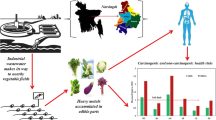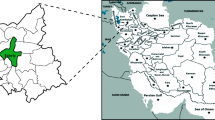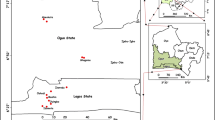Abstract
The present study investigated the heavy metal (HM) accumulation in some food items and associated potential human health risk in the Prakasam district. Food samples were collected from 9 villages of different mandals mainly comprising of rice, wheat, green gram, red gram, black gram, potato, and amaranthus. The HMs chromium (Cr), arsenic (As), lead (Pb), cadmium (Cd), and mercury (Hg) were analyzed by Inductively Coupled Plasma Mass Spectroscopy (ICPMS). The results showed that the HM concentrations in vegetables were higher than the cereals and pulses. The decreasing order of HM concentrations were observed as Cr > As > Pb > Cd > Hg, Cr > Pb > As = Cd > Hg and Cr > Pb > Cd > As > Hg in cereals, pulses, and vegetables, respectively. The dietary intake of cereals and vegetables contributed more exposure to HMs. The hazard index (HI) in case of cereals (3.648) and vegetables (1.003) exceeded 1 indicating the non-carcinogenic risk when these food items are consumed by adults. The HI in case of cereals (7.106) and vegetables (1.747) exceeded 1 indicating the health risks when these food items were consumed by children. The HI for cereals and vegetables in case of children is almost double to the HI of adults. The lifetime cancer risk was observed for Cr via consumption of rice and amaranthus, both in adults and children. In conclusion, health risk due to consumption of cereals and vegetables revealed both non-carcinogenic and carcinogenic risk for adults and children. The findings of the present study can be used for the development of potential strategies for risk control and management.



Similar content being viewed by others
Data Availability
The raw and statistically tested data is available with statistics department and corresponding author.
Code Availability
Not applicable.
References
Huang Z, Pan XD, Wu PG, Han JL, Chen Q (2014) Heavy metals in vegetables and the health risk to population in Zhejiang, China. Food Control 36:248–252
Liang G, Liu XH, Pan LG (2017) Assessment of typical heavy metals in human hair of different age groups and foodstuffs in Beijing, China. Int J Environ Res Public Health 14(914):1–10
Wang X, Sato T, Xing B, Tao S (2005) Health risks of heavy metals to the general public in Tianjin, China via consumption of vegetables and fish. Sci Total Environ 350:28–37
Liu G, Wang J, Zhang E, Hou J, Liu X (2016) Heavy metal speciation and risk assessment in dry land and paddy soils near mining areas at Southern China. Environ Sci Pollut Res 23:8709–8720
Wu MYC, Hsu MY, Chen SJ, Hwang DK, Yen TH, Cheng CM (2017) Point-of-care detection devices for food safety monitoring: proactive disease prevention. Trends Biotechnol 35:288–300
Mahmood A, Malik RN (2014) Human health risk assessment of heavy metals via consumption of contaminated vegetables collected from different irrigation sources in Lahore, Pakistan. Arab J Chem 7:91–99
Vinod K, Anket S, Parminder K, Gagan PSS, Aditi SB, Renu B, Ashwani KT, Artemi C (2019) Pollution assessment of heavy metals in soils of India and ecological risk assessment: a state-of-the-art. Chemosphere 216:449–462
Khan S, Cao Q, Zheng Y, Huang Y, Zhu Y (2008) Health risks of heavy metals in contaminated soils and food crops irrigated with waste water in Beijing, China. Environ Pollut 152:686–692
Li GC, Tian L, Wang YH, Wang SC, Li B, Cui JH, Zhang H (2014) Progresses on risk assessment methods of bioavailability of heavy metal in soils. J Food Saf Qual 5:3592–3597
Chan SM, Wang WX, Ni IH (2003) The uptake of Cd, Cr, and Zn by the macroalga enteromorpha crinita and subsequent transfer to the marine herbivorous rabbitfish, siganus canaliculatus. Arch Environ Contam Toxicol 44:298–306
Jafarian-Dehkordi A, Alehashem M (2013) Heavy metal contamination of vegetables in Isfahan. Iran Res Pharma Sci 8:51–58
Wagner GJ (1993) Accumulation of cadmium in crop plants and its consequences to human health. Adv Agron 51:173–212
Li Z, Ma Z, van der Kuijp TJ, Yuan Z, Huang L (2014) A review of soil heavy metal pollution from mines in China: pollution and health risk assessment. Sci Total Environ Volumes 468–469:843–853
Aicha S, Asmae B, Rachid BA, Naima M, Alistair A, Mohammed H, Abdellah Z (2020) Trace elements in breakfast cereals and exposure assessment in Moroccan population: case of lead and cadmium. Biol Trace Elem Res 1268–1275
Zuo-WZ C-SM, Takao W, Shinichiro S, Masayuki I (1997) Contents of pollutant and nutrient elements in rice and wheat grown on the neighboring fields. Biol Trace Elem Res 57:39–50
Nabi S, Amir (Amir Khan) SMN, Ayub EF (2016) Assessment of heavy metal content in refined and unrefined salts obtained from Urmia, Iran. Toxin Rev Early Online:1–5 36:89–93
Gao Y, Shi ZM, Long Z, Wu P, Zheng CB, Hou XD (2012) Determination and speciation of mercury in environmental and biological samples by analytical atomic spectrometry. Microchem J 103:1–14
Cortes E, Toro E, Das HA, Fardy JJ, Bin Hamzah Z, Iyer RK, Laiyan Sun, Leelhaphunt N, Muramatsu Y, Parr RM, Qureshi IH, Resnizky SM, Surtipanti S, Tarafdar SA, Vasconcellos MBA (1994) Toxic heavy metals and other trace elements in foodstuffs from 12 different countries. Nuclear Analytical Methods in the Life Sciences 415–422
Tong S, Schirnding YE, Prapamontol T (2000) Environmental lead exposure: a public health problem of global dimensions. Bull World Health Organ 78:1068–1077
Chang CY, Yu HY, Chen JJ, Li FB, Zhang HH, Liu CP (2014) Accumulation of heavy metals in leaf vegetables from agricultural soils and associated potential health risks in the Pearl River Delta, South China. Environ Monit Assess 186:1547–1560
Liu G, Yu Y, Hou J, Xue W, Liu X, Liu Y, Wang W, Alsaedi A, Hayat T, Liu Z (2014) An ecological risk assessment of heavy metal pollution of the agricultural ecosystem near a lead-acid battery factory. Ecol Indic 47:210–218
Kim HJ, Lim HS, Lee KR, Choi MH, Kang NM, Lee CH, Oh EJ, Park HK (2017) Determination of trace metal levels in the general population of Korea. Int J Environ Res Public Health 14:702
Kaare J, Amund M, Hilde SK, Karl HG, Lars J, Peter F, Dawn D (2013) Determination of arsenic,cadmium, mercury, and lead in foods by pressure digestion and inductively coupled plasma/ mass spectrometry:first action 2013.06. J AOAC Int 96(5):1101–1102
National Nutrition Monitoring Bureau (2012) Diet and Nutritional Status of Rural Population,Prevalence of Hypertension & Diabetes among Adults and Infant & Young Child feeding Practices—Report of thirdRepeat Survey. Report of Third Repeat Survey
USEPA (1989) Risk assessment guidance for superfund, human health evaluation manual (part A). Interim final (Vol. I). United States Environmental Protection Agency, Washington, DC (EPA/540/1–89/002)
USEPA IRIS (2011) Integrated risk information system. Environmental protection agency region I, Washington DC, 20460
US EPA. (2011) Exposure factors handbook: 2011 Edition. Washington: U.S. Environmental Protection Agency EPA/ 600/R-090/052F
Miri M, Shendi MRA, Ghaffari HR, Aval HE, Ahmadi E, Taban E et al (2016) Investigation of outdoor BTEX: concentration, variations, sources, spatial distribution and risk assessment. Chemosphere 163:601–609
Zeng F, Wei W, Li M, Huang R, Yang F, Duan Y (2015) Heavy metal contamination in rice-producing soils of Hunan province, China and potential health risks. Int J Environ Res Public Health 12(12):15584–15593
Antoine JMR, Fung LAH, Grant CN (2017) Assessment of the potential health risks associated with the aluminium, arsenic, cadmium and lead content in selected fruits and vegetables grown in Jamaica. Toxicol Rep 4:181–187
Yang J, Ma S, Zhou J, Song Y, Li F (2018) Heavy metal contamination in soils and vegetables and health risk assessment of inhabitants in Daye. China J Int Med Res 46(8):3374–3387
Kamunda C, Mathuthu M, Madhuku M (2016) Health risk assessment of heavy metals in soils from witwatersrand Gold Mining Basin, South Africa. Int J Environ Res Public Health 13(663):1–11
USEPA (2005) Guidelines for carcinogen risk assessment. Environmental Protection Agency, Washington
Emmanuel TT, Tonye O (2011) Bioconcentration of trace metals in the tissues of two leafy vegetables widely consumed in South West Nigeria. Biol Trace Elem Res 140:215–224
Srek P, Hejcman M, Kunzova E (2012) Effect of long-term cattle slurry and mineral N, P and K application on concentrations of N, P, K, Ca, Mg, As, Cd, Cr, Cu, Mn, Ni, Pb and Zn in peeled potato tubers and peels. Plant Soil Environ 58:167–173
LeRiche EL, Wang-Pruski G, Zheljazkov VD (2009) Distribution of elements in potato (Solanum tuberosum L.) tubers and their relationship to after-cooking darkening. HortScience 44:1866–1873
Yang Y, Zhang FS, Li HF et al (2009) Accumulation of cadmium in the edible parts of six vegetable species grown in Cd-contaminated soils. J Environ Manage 90:1117–1122
Yana C, Kelin L, Jian Z et al (2012) Analysis of heavy metal pollution in soil-vegetables at mining area in Hunan. Chinese Agricult Sci bulletin 28:226–232
Tani FH, Barrington S (2005) Zinc and copper uptake by plants under two transpiration ratios Part I. Wheat (Triticum aestivum L.). Environ Pollut 138:538–547
Jun Y, Ma S, Jingcheng Z, Yongwei S, Li F (2018) Heavy metal contamination in soils and vegetables and health risk assessment of inhabitants in Daye, China. J Int Med Res 46:3374–3387
Marin AR, Masscheleyn P, Patrick WH (1993) Soil redoxe-pH stability of arsenic species and its influence on arsenic uptake by rice. Plant Soil 152:245–253
Williams PN, Villada A, Deacon C, Raab A, Figuerola J et al (2007) Greatly enhanced arsenic shoot assimilation in rice leads to elevated grain concentrations compared to wheat and barley. Environ Sci Technol 41:6854–6859
Ana B, Martinadal JLD (2005) Human exposure to metals through the diet in Tarragona, Spain. Biol Trace Elem Res 104:193–201
Fu J, Zhou Q, Liu J, Liu W, Wang T et al (2008) High levels of heavy metals in rice (Oryza sativa L.) from a typical E-waste recycling area in southeast China and its potential risk to human health. Chemosphere 71:1269–1275
Huang X, Wang H, Zhou J, Ma C, Du C et al (2009) Risk assessment of potentially toxic element pollution in soils and rice (Oryza sativa) in a typical area of the Yangtze River Delta. Environ Pollut 157:2542–2549
Nabi S, Mohammad R, Mahmood AS, Mahmood A, Majid A (2020) Assessment of rice marketed in Iran with emphasis on toxic and essential elements; effect of different cooking methods. Biol Trace Elem Res 198:721–731
Cao S, Duan X, Zhao X, Wang B, Ma J, Fan D, Sun C, He B, Wei F, Jiang G (2015) Health risk assessment of various metal(loid)s via multiple exposure pathways on children living near a typical lead-acid battery plant, China. Environ Pollut 200:16–23
Amin K, Majid A, Mojtaba M, Nabi S, Saeed A, Gholamreza JK, Mosaad AW, Saeed S (2021) Probabilistic health risk assessment of trace elements in baby food and milk powder using ICP-OES method. Biol Trace Elem Res. https://doi.org/10.1007/s12011-021-02808-w
Hadis K, Sr N, Shahrokh N, Mojtaba M, Babak M, Amin MK (2020) The concentration and probabilistic health risk of potentially toxic elements (PTEs) in edible mushrooms (wild and cultivated) samples collected from different cities of Iran. Biol Trace Elem Res 199:389–400
Acknowledgements
The authors acknowledge the encouragement and guidance of the Director, ICMR-National Institute of Nutrition, India. The authors thank the ICMR for financial assistance to conduct the study.
Funding
The project was funded by the Indian Council of Medical Research, India.
Author information
Authors and Affiliations
Contributions
Dr. ALK contributed to the conception and design, acquisition of data, and interpretation of data. Dr. V.V contributed to the acquisition of data and drafting the article. RPJ contributed to the laboratory analysis, SD contributed to the laboratory analysis, SK contributed to laboratory analysis, AC contributed to the heavy metal analysis, NB contributed to data statistical analysis, and LT contributed to the interpretation of the data.
Corresponding author
Ethics declarations
Conflict of Interest
The authors declare no competing interests.
Additional information
Publisher's Note
Springer Nature remains neutral with regard to jurisdictional claims in published maps and institutional affiliations.
Rights and permissions
About this article
Cite this article
Khandare, A.L., Validandi, V., Jamalpur, R.P. et al. Potential Health Risks Associated with the Heavy Metal Content in Commonly Consumed Food from Prakasam District of Andhra Pradesh, India. Biol Trace Elem Res 200, 3453–3461 (2022). https://doi.org/10.1007/s12011-021-02918-5
Received:
Accepted:
Published:
Issue Date:
DOI: https://doi.org/10.1007/s12011-021-02918-5




